Papers by Curtis R Congreve

Palaeontology, 2016
Implied weighting, a method for phylogenetic inference that actively seeks to downweight supposed... more Implied weighting, a method for phylogenetic inference that actively seeks to downweight supposed homoplasy, has in recent years begun to be widely utilized in palaeontological datasets. Given the method's purported ability at handling widespread homoplasy/convergence, we investigate the effects of implied weighting on modelled phylogenetic data. We generated 100 character matrices consisting of 55 characters each using a Markov Chain morphology model of evolution based on a known phylogenetic tree. Rates of character evolution in these datasets were variable and generated by pulling from a gamma distribution for each character in the matrix. These matrices were then analysed under equal weighting and four settings of implied weights (k = 1, 3, 5, and 10). Our results show that implied weighting is inconsistent in its ability to retrieve a known phylogenetic tree. Equally weighted analyses are found to generally be more conservative, retrieving higher frequency of polytomies but being less likely to generate erroneous topologies. Implied weighting is found to generally resolve polytomies while also propagating errors, resulting in an increase in both correctly and incorrectly resolved nodes with a tendency towards higher rates of error compared to equal weighting. Our results suggest that equal weights may be a preferable method for parsimony analysis.

Paleobiology
The burgeoning field of phylogenetic paleoecology (Lamsdell et al. 2017) represents a synthesis o... more The burgeoning field of phylogenetic paleoecology (Lamsdell et al. 2017) represents a synthesis of the related but differently focused fields of macroecology (Brown 1995) and macroevolution (Stanley 1975). Through a combination of the data and methods of both disciplines, phylogenetic paleoecology leverages phylogenetic theory and quantitative paleoecology to explain the temporal and spatial variation in species diversity, distribution, and disparity. Phylogenetic paleoecology is ideally situated to elucidate many fundamental issues in evolutionary biology, including the generation of new phenotypes and occupation of previously unexploited environments; the nature of relationships among character change, ecology, and evolutionary rates; determinants of the geographic distribution of species and clades; and the underlying phylogenetic signal of ecological selectivity in extinctions and radiations. This is because phylogenetic paleoecology explicitly recognizes and incorporates the qu...
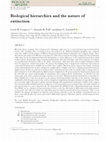
Biological Reviews
Hierarchy theory recognises that ecological and evolutionary units occur in a nested and intercon... more Hierarchy theory recognises that ecological and evolutionary units occur in a nested and interconnected hierarchical system, with cascading effects occurring between hierarchical levels. Different biological disciplines have routinely come into conflict over the primacy of different forcing mechanisms behind evolutionary and ecological change. These disconnects arise partly from differences in perspective (with some researchers favouring ecological forcing mechanisms while others favour developmental/historical mechanisms), as well as differences in the temporal framework in which workers operate. In particular, long-term palaeontological data often show that large-scale (macro) patterns of evolution are predominantly dictated by shifts in the abiotic environment, while short-term (micro) modern biological studies stress the importance of biotic interactions. We propose that thinking about ecological and evolutionary interactions in a hierarchical framework is a fruitful way to resolve these conflicts. Hierarchy theory suggests that changes occurring at lower hierarchical levels can have unexpected, complex effects at higher scales due to emergent interactions between simple systems. In this way, patterns occurring on short-and long-term time scales are equally valid, as changes that are driven from lower levels will manifest in different forms at higher levels. We propose that the dual hierarchy framework fits well with our current understanding of evolutionary and ecological theory. Furthermore, we describe how this framework can be used to understand major extinction events better. Multi-generational attritional loss of reproductive fitness (MALF) has recently been proposed as the primary mechanism behind extinction events, whereby extinction is explainable solely through processes that result in extirpation of populations through a shutdown of reproduction. While not necessarily explicit, the push to explain extinction through solely population-level dynamics could be used to suggest that environmentally mediated patterns of extinction or slowed speciation across geological time are largely artefacts of poor preservation or a coarse temporal scale. We demonstrate how MALF fits into a hierarchical framework, showing that MALF can be a primary forcing mechanism at lower scales that still results in differential survivorship patterns at the species and clade level which vary depending upon the initial environmental forcing mechanism. Thus, even if MALF is the primary mechanism of extinction across all mass extinction events, the primary environmental cause of these events will still affect the system and result in differential responses. Therefore, patterns at both temporal scales are relevant.
The new and emerging field of phylogenetic paleoecology leverages the evolutionary relationships ... more The new and emerging field of phylogenetic paleoecology leverages the evolutionary relationships among species to explain temporal and spatial changes in species diversity, abundance, and distribution in deep time. This field is poised for rapid progress as knowledge of the evolutionary relationships among fossil species continues to expand. In particular, this approach will lend new insights to many of the longstanding questions in evolutionary biology, such as: the relationships among character change, ecology, and evolutionary rates; the processes that determine the evolutionary relationships among species within communities and along environmental gradients; and the phylogenetic signal underlying ecological selectivity in background and mass extinctions and in major evolutionary radiations.
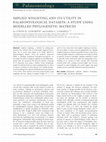
Implied weighting, a method for phylogenetic inference that actively seeks to downweight supposed... more Implied weighting, a method for phylogenetic inference that actively seeks to downweight supposed homo-plasy, has in recent years begun to be widely utilized in palaeontological datasets. Given the method's purported ability at handling widespread homoplasy/convergence, we investigate the effects of implied weighting on modelled phylo-genetic data. We generated 100 character matrices consisting of 55 characters each using a Markov Chain morphology model of evolution based on a known phylogenetic tree. Rates of character evolution in these datasets were variable and generated by pulling from a gamma distribution for each character in the matrix. These matrices were then analysed under equal weighting and four settings of implied weights (k = 1, 3, 5, and 10). Our results show that implied weighting is inconsistent in its ability to retrieve a known phylogenetic tree. Equally weighted analyses are found to generally be more conservative, retrieving higher frequency of polytomies but being less likely to generate erroneous topologies. Implied weighting is found to generally resolve polytomies while also propagating errors, resulting in an increase in both correctly and incorrectly resolved nodes with a tendency towards higher rates of error compared to equal weighting. Our results suggest that equal weights may be a preferable method for parsimony analysis.
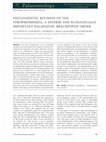
Palaeontology, 2015
The order Strophomenida was an ecologically abundant and taxonomically diverse group of Palaeozoi... more The order Strophomenida was an ecologically abundant and taxonomically diverse group of Palaeozoic brachiopods that originated in the earliest Ordovician and went extinct in the Carboniferous. During their long geological range, the Strophomenida survived two of the 'Big Five' mass extinction events, the Late Ordovician and the Late Devonian, suggesting that they are potentially informative taxa for studying the evolutionary effects of these two distinct mass extinctions, each with drastically different forcing mechanisms. However, while there have been previous phylogenetic studies on smaller groups within the Strophomenida, the phylogenetic relationships of the whole group are still largely unknown. The group has been divided into two major superfamilies, the Strophomenoidea (strophomenoids) and the Plectambonitoidea (plectambonitoids). Despite being treated as separate clades, the plectambonitoids may form a paraphyletic grade into the strophomenoids. We present a detailed higher-level parsimony-based phylogenetic analysis of the Strophomenida, consisting of 69 characters and 62 exemplar species sampled from the majority of the taxonomically defined families/subfamilies. Several species of basal chonetids (strophochonetids) were also included in this analysis, as they may be closely related to the Strophomenida and share several characters with both the plectambonitoids and strophomenoids. The phylogenetic analysis suggests the plectambonitoids, as originally defined, are paraphyletic to the monophyletic strophomenoids. The basal chonetids are reconstructed as a monophyletic group that is sister to the strophomenoids, suggesting that their proper placement might be within the Strophomenida. The topology also suggests that at least 17 of the taxonomically defined strophomenoid and plectambonitoid families are likely to be monophyletic. The Plectambonitidae and the Taffiidae as defined are paraphyletic, and the Grorudiidae and Leptostrophiidae are polyphyletic. Furthermore, subfamilies Leptodontellinae, Dicoelostrophiinae, Palaeostrophomeninae and Aegiromeninae are raised to the level of family. When analysed within this phylogenetic context, the Late Ordovician mass extinction event had little effect on the large-scale evolution of the group.
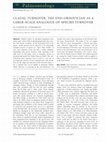
Palaeontology, 2013
Modern studies of individual populations have shown large cyclical shifts in phenotype/genotype t... more Modern studies of individual populations have shown large cyclical shifts in phenotype/genotype that correlate with climatic variations. At the hierarchical level of the species, similar patterns can be observed in the climatically mediated turnover of species (i.e. Vrba's Relay Model). In turn, mass extinction events may have a similar analogous relationship with species turnover, while operating at the clade level. In this paper, such an analogous process is described and named 'the Cladal Turnover Model'. The end-Ordovician mass extinction event is used as a test case to investigate the existence of such a phenomenon, with specific focus on the origin and extinction of the Hirnantia fauna. A test is outlined that can be applied to determine whether Cladal Turnover is occurring in the end-Ordovician. An example case study is then performed on the Hirnantia trilobite genus 'Brongniartella'. The results of this test suggest that while the taxon 'Brongniartella' is derived from putatively cold-water high-latitude stock (consistent with the classical definition of Hirnantia taxa), the group does not go extinct at the end-Ordovician event, but instead gives rise to warm-water low-latitude descendants. This result is consistent with the Cladal Turnover Model. The method proposed for testing the Cladal Turnover Model could be applied to look at other times of major evolutionary turnover preserved in the fossil record.
Astrobiology, 2013
Astrobiology is a transdisciplinary field with extraordinary potential for the scientific communi... more Astrobiology is a transdisciplinary field with extraordinary potential for the scientific community. As such, it is important to educate the community at large about the growing importance of this field to increase awareness and scientific content learning and expose potential future scientists. To this end, we propose the creation of a traveling museum exhibit that focuses exclusively on astrobiology and utilizes modern museum exhibit technology and design. This exhibit (the ''Astrobiology Road Show''), organized and evaluated by an international group of astrobiology students and postdocs, is planned to tour throughout the Americas.
Journal of Paleontology, 2010
Cladistic parsimony analysis of the subfamily Deiphoninae Raymond, 1913, was conducted to produce... more Cladistic parsimony analysis of the subfamily Deiphoninae Raymond, 1913, was conducted to produce a hypothesis of relationship for the group. The genera Deiphon Barrande, 1850 and Onycopyge Woodward, 1880 are found to be monophyletic, while the genus Sphaerocoryphe Angelin, 1854, as it was previously defined, is paraphyletic. A modified Brooks Parsimony Analysis using the phylogenetic hypothesis reveals patterns of biogeography, in particular, vicariance and geodispersal, during the Ordovician-Silurian. The analysis yields three major conclusions about deiphonine biogeography: Eastern Laurentia and Baltica were close enough during the late Ordovician to exchange taxa via sea level rise and fall; chance dispersal occurred between Northwestern Laurentia and Australia; and deiphonine trilobites likely originated in Baltica or Eastern Laurentia.
Phylogenetic and Biogeographic Analysis of Ordovician Homalonotid Trilobites
The Open Paleontology Journal, 2008
PLOS One, 2011
Background: Sphaerexochinae is a speciose and widely distributed group of cheirurid trilobites. T... more Background: Sphaerexochinae is a speciose and widely distributed group of cheirurid trilobites. Their temporal range extends from the earliest Ordovician through the Silurian, and they survived the end Ordovician mass extinction event (the second largest mass extinction in Earth history). Prior to this study, the individual evolutionary relationships within the group had yet to be determined utilizing rigorous phylogenetic methods. Understanding these evolutionary relationships is important for producing a stable classification of the group, and will be useful in elucidating the effects the end Ordovician mass extinction had on the evolutionary and biogeographic history of the group.
Background: Sphaerexochinae is a speciose and widely distributed group of cheirurid trilobites. T... more Background: Sphaerexochinae is a speciose and widely distributed group of cheirurid trilobites. Their temporal range extends from the earliest Ordovician through the Silurian, and they survived the end Ordovician mass extinction event (the second largest mass extinction in Earth history). Prior to this study, the individual evolutionary relationships within the group had yet to be determined utilizing rigorous phylogenetic methods. Understanding these evolutionary relationships is important for producing a stable classification of the group, and will be useful in elucidating the effects the end Ordovician mass extinction had on the evolutionary and biogeographic history of the group.

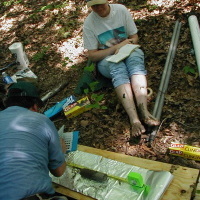








Uploads
Papers by Curtis R Congreve